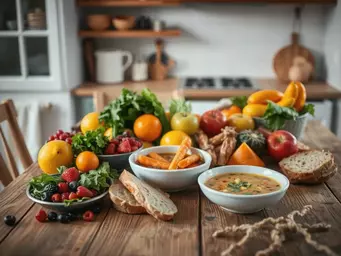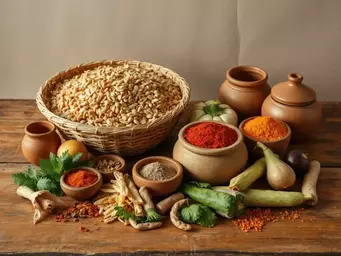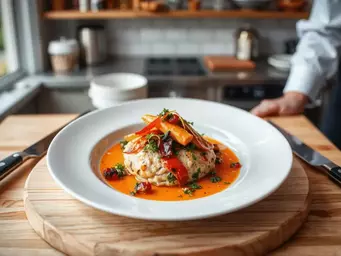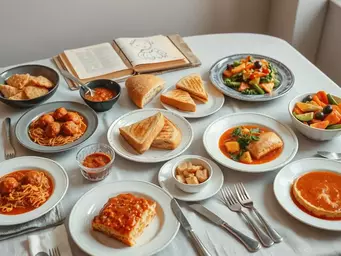Have you ever wondered why certain foods evoke such strong emotions? Your culinary experiences are not merely about taste; they’re intertwined with powerful memories that shape your eating habits.
What You Will Learn
- Emotional food memories influence our food preferences and choices.
- Specific emotions can trigger cravings for certain comfort foods.
- Nostalgia significantly shapes our culinary experiences and preferences.
- Recognizing emotional triggers can help manage unhealthy eating habits.
- Practical steps like keeping a food diary can enhance awareness of emotional eating.
- Engaging with our emotional landscape fosters a healthier relationship with food.
The Interconnectedness of Emotional Food Memories and Eating Behaviors
This visual explores the core components of emotional food memories and their impact on our eating habits and overall well-being.
Defining Emotional Food Memories
Feelings associated with specific foods/meals (joy, sadness).
- Personal experiences
- Cultural significance
- Shared meals
Emotions & Food Choices
Emotional states (stress, happiness) influence what we eat.
- Triggers cravings
- Comfort food seeking
- Unhealthy habit triggers
The Power of Nostalgia
Nostalgia brings back vivid sensory memories (smell, taste).
- Influences preferences
- Can override nutrition
- Mindful balance needed
Addressing Emotional Eating
Crucial for physical and mental health; focuses on 'why' we eat.
- Identify triggers
- Replace unhealthy patterns
- Sustainable lifestyle
Steps to Manage Eating
Actionable steps to foster a healthier relationship with food.
- Food diary & emotions
- Mindfulness during meals
- Seek support (friends/pros)
Food Diaries for Self-Awareness
Documenting meals + emotions to identify patterns.
- Mood-food connections
- Cravings & feelings
- Guilt vs. satisfaction
Understanding Emotional Food Memories and Their Impact on Eating Behaviors
Food is so much more than just sustenance; it’s a tapestry woven with our emotional food memories. These memories shape how we view flavors, textures, and even the act of eating itself. They are the stories we carry with us, often tied to significant moments in our lives. When I reflect on my own culinary journey, it’s easy to see how these emotional threads influence my connections with food.
Perhaps you've had a dish that made you feel a warm wave of nostalgia or joy. That's the beauty of emotional food memories—they highlight the profound relationship between our feelings and our eating habits. Understanding this connection can help us appreciate the deeper narratives behind our meals!
Defining Emotional Food Memories: What Are They?
At its core, emotional food memories encompass the feelings we associate with specific foods and meals. These memories can evoke a range of emotions from joy to sadness, often linked to significant events, people, or traditions. For instance, think back to a holiday gathering where a particular dish was served. Does that dish transport you back to a cherished moment? That’s the magic of emotional food memories at work. For a deeper dive into how our past shapes our present, explore this article on the power of mindful eating.
- Personal experiences tied to specific meals
- Cultural significance of dishes
- Impact of shared meals with loved ones
These memories shape our preferences and can significantly influence our choices at the dining table. Recognizing them is the first step in understanding how they affect our relationship with food over time.

The Connection Between Emotions and Food Choices
Our emotions play a pivotal role in shaping what we eat. When we experience stress or happiness, our food choices often reflect those feelings. Comfort foods, for example, are frequently sought during times of emotional distress, providing solace and familiarity. When I crave a rich chocolate cake, it's not just about satisfying my sweet tooth—it's about reminiscing on family celebrations where cake was always present.
- Emotional states that influence cravings
- Foods associated with specific emotions
- Understanding triggers for unhealthy eating habits
By identifying these connections, we can better navigate our eating behaviors and make conscious choices that align with our emotional health.
The Role of Nostalgia in Shaping Food Memories
Nostalgia is a powerful emotion that can significantly shape our food memories. It often brings back vivid images of past gatherings, flavors, and scents that we hold dear. Just as I cherish the scent of my grandmother's tomato sauce simmering on the stove, many people have similar nostalgic triggers that can influence their culinary preferences today. This emotional connection can sometimes lead to choices that are less about nutrition and more about comfort. Discover more about how to make healthier food choices in our guide on healthy eating on a budget.
- Examples of nostalgic dishes
- How nostalgia affects current food choices
- Balancing nostalgia with healthy eating
Understanding the role of nostalgia in our food memories can help us navigate our culinary experiences more mindfully. It allows us to appreciate the past while making choices that enhance our present health and well-being.
Pro Tip
Did you know? Keeping a food diary not only helps track your meals but also provides insight into the emotional triggers behind your food choices. By documenting how you feel before, during, and after eating, you can uncover patterns that may influence your cravings and overall relationship with food.
Summarizing Key Insights on Emotional Food Memories
As we’ve explored, our emotional food memories play a significant role in shaping our eating behaviors. These memories can evoke strong feelings, influence our food choices, and even dictate our cravings. By understanding how our emotions tie to the meals we cherish, we gain insights into our dietary patterns and preferences.
Recognizing this connection allows us to approach our eating habits more mindfully. The emotions tied to food can also lead us down paths of comfort or guilt. It's essential to navigate these feelings with care. When we acknowledge the impact of our emotional experiences on our food choices, we foster a healthier relationship with what we consume.
Recap of the Connection Between Emotions and Eating
- Emotional memories can trigger cravings for specific foods.
- Food serves as a comfort during emotional distress.
- Nostalgia can influence our preference for traditional dishes.
- Understanding these connections helps in identifying emotional triggers.
This recap highlights the importance of recognizing the emotional context behind our meals. As we delve deeper into our food journeys, we can better understand why we gravitate toward certain dishes at different times.
The Significance of Addressing Emotional Eating for Better Health
Addressing emotional eating is crucial for maintaining both physical and mental health. By recognizing the emotional triggers that lead us to eat, we can take proactive steps to improve our relationship with food. It's not just about what we eat; it's also about why we eat it!
Engaging with our emotional landscapes allows us to replace unhealthy patterns with healthier options. This shift can lead to improved well-being and a more balanced lifestyle. By integrating strategies to manage emotional eating, we can create a sustainable and enjoyable approach to our diets.

Encouraging a Healthier Relationship with Food
Next Steps for Readers to Manage Emotional Eating
If you're eager to improve your relationship with food, here are some actionable steps to consider:
- Begin a food diary to track what you eat and how you feel.
- Practice mindfulness during meals to enhance your awareness of emotional triggers.
- Seek support from friends or professionals if emotional eating feels overwhelming.
- Explore new recipes that resonate with positive memories.
These steps can help you cultivate a relationship with food that is not only enjoyable but also nourishing for your soul. Remember, each bite can be a step toward understanding yourself better!
Additional Resources for Further Exploration
For those looking to dig deeper into the fascinating world of emotional eating, I recommend exploring the following resources:
- Books on the psychology of food and eating.
- Online courses focused on mindful eating practices.
- Support groups that share experiences and coping strategies.
- Podcasts featuring discussions about emotional connections with food.
These resources can enrich your journey and provide valuable insights. As we continue to explore the narratives behind our meals, the stories we tell ourselves about food can transform our lives!
Developing Food Diaries to Enhance Self-Awareness
Creating a food diary is a powerful tool for enhancing self-awareness. By documenting not only what you eat but also the emotions you experience, you can identify patterns that may influence your eating habits. This practice can reveal connections between your mood and food choices, helping you understand your emotional landscape better! For additional guidance on improving your eating habits, consider reading our advice on how to start a healthy diet.
When keeping a food diary, consider noting the following:
- The meals you enjoyed and what emotions you were feeling when you ate them.
- Any cravings or urges that arose and their associated feelings.
- Times when you felt satisfied versus times when you felt guilt or shame.
- Any discoveries about food preferences tied to your memories.
By reflecting on these entries, you can gradually shift your relationship with food, paving the way for a more mindful and fulfilling culinary experience. Each meal can become more than just sustenance—it can tell a story of who you are and where you’ve been. Let’s keep uncovering these stories together, one bite at a time!
Frequently Asked Questions About Emotional Food Memories
What are emotional food memories?
Emotional food memories are feelings and associations we connect with specific foods or meals, often linked to significant life events, people, or traditions. They can evoke a wide range of emotions, from joy to sadness.
How do emotions influence our food choices?
Our emotional states, such as stress or happiness, significantly impact what we choose to eat. For example, comfort foods are often sought during emotional distress, while celebratory meals are linked to positive feelings.
What role does nostalgia play in food memories?
Nostalgia is a powerful emotion that triggers vivid sensory memories of past meals, flavors, and scents. These nostalgic triggers can influence our current culinary preferences, sometimes leading us to choose foods for comfort over nutritional value.
Why is addressing emotional eating important for health?
Addressing emotional eating is crucial for both physical and mental well-being. By recognizing the emotional triggers behind our eating habits, we can develop healthier coping mechanisms and foster a more balanced and sustainable relationship with food.
How can a food diary help manage emotional eating?
A food diary helps enhance self-awareness by documenting not only what you eat but also the emotions you experience before, during, and after meals. This practice can reveal patterns between your mood and food choices, helping you identify triggers and make more mindful decisions.
Recap of Key Points
Here is a quick recap of the important points discussed in the article:
- Emotional food memories shape our eating behaviors and preferences.
- Emotions significantly influence our food choices, especially during stressful times.
- Nostalgia plays a key role in the foods we associate with comfort and joy.
- Recognizing emotional triggers can help us manage unhealthy eating habits.
- Keeping a food diary can enhance self-awareness and improve our relationship with food.







